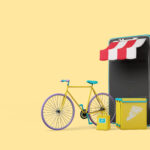
How to Start a Dropshipping Business in 2025: A Beginner-Friendly Guide
If you’ve been looking for a low-risk way to break into eCommerce, dropshipping is one of the best business models to consider in 2025. With minimal upfront investment and a flexible setup, it’s no wonder this model continues to grow in popularity.
Table Of Content
- What is Dropshipping?
- How Dropshipping Works (Simplified)
- Why Start a Dropshipping Business in 2025?
- Key Benefits of Dropshipping
- Is Dropshipping Still Profitable in 2025?
- What Makes Dropshipping Profitable Today
- Step-by-Step: How to Start a Dropshipping Business in 2025
- 1. Choose a Niche You Understand
- 2. Conduct Market Research
- 3. Select a Reliable Dropshipping Platform
- 4. Find Trusted Suppliers
- 5. Build Your Online Store
- 6. Set Up Payment Gateways
- 7. Price Your Products Strategically
- 8. Launch and Market Your Store
- Table: Pros and Cons of Dropshipping
- What I Learned Running a Dropshipping Store
- Common Mistakes to Avoid
- Trustworthy Tools and Resources
- Future of Dropshipping: Trends to Watch in 2025
- Final Thoughts
- Start Your Dropshipping Business Journey Today
In this comprehensive guide, you’ll learn everything you need to know to start a profitable dropshipping business — backed by real-world experience, expert insights, and data-driven strategies.
What is Dropshipping?
Dropshipping is a retail fulfillment method where a store doesn’t keep the products it sells in stock. Instead, when a customer places an order, the store purchases the item from a third-party supplier who ships it directly to the customer.
You never handle the products yourself. This allows you to start an online store with little overhead, focusing more on marketing and customer service.
How Dropshipping Works (Simplified)
- A customer places an order on your online store.
- You forward the order to your supplier.
- The supplier ships the product directly to the customer.
- You keep the profit (your price – supplier cost).
Why Start a Dropshipping Business in 2025?
The eCommerce industry is booming. According to Statista, global retail eCommerce sales are expected to exceed $7 trillion by 2025.
Key Benefits of Dropshipping:
- Low Startup Costs: No inventory or warehouse needed.
- Flexibility: Run your business from anywhere.
- Scalability: Easily test and expand product offerings.
With AI-driven tools and easier integrations, 2025 is arguably the best time to enter the dropshipping space.
Is Dropshipping Still Profitable in 2025?
Yes — but only if approached with strategy. Dropshipping isn’t a “get-rich-quick” scheme. Like any real business, it requires time, testing, and commitment.
What Makes Dropshipping Profitable Today:
- Data-driven marketing strategies.
- Niche-specific branding.
- Automated operations.
In fact, a Shopify report notes that top-performing dropshipping stores in 2024 had an average profit margin between 15-30%, depending on the niche and marketing efficiency.
Step-by-Step: How to Start a Dropshipping Business in 2025
1. Choose a Niche You Understand
Your niche defines your audience, branding, and marketing approach. Focus on something you’re passionate about or knowledgeable in.
Examples of Profitable Niches in 2025:
- Eco-friendly products
- Home fitness gear
- Pet accessories
- Smart home gadgets
2. Conduct Market Research
Analyze your competitors, identify pricing trends, and use tools like Google Trends, JungleScout, and Semrush to validate demand.
3. Select a Reliable Dropshipping Platform
Some beginner-friendly platforms to consider:
- Shopify (easy-to-use, with app integrations like Oberlo or DSers)
- WooCommerce (WordPress-based, customizable)
- BigCommerce (robust for scaling)
Pro Tip: Shopify is ideal for beginners due to its clean UI and strong support system.
4. Find Trusted Suppliers
A supplier can make or break your store. Choose those with fast shipping, good communication, and high product quality.
Top Platforms for Sourcing Products:
- AliExpress
- Spocket
- CJ Dropshipping
- Zendrop
5. Build Your Online Store
Make sure your website is:
- User-Friendly: Easy navigation, mobile-friendly design.
- Trust-Building: Add About Us, FAQ, Return Policy, and Contact pages.
- Optimized for Conversion: Use persuasive copy, reviews, and strong CTAs.
6. Set Up Payment Gateways
Popular payment processors include:
- PayPal
- Stripe
- Shopify Payments
Ensure your payment process is secure and seamless.
7. Price Your Products Strategically
Factor in:
- Product cost
- Shipping
- Marketing budget
- Target profit margin
Use pricing psychology (e.g., $19.99 instead of $20) to boost conversions.
8. Launch and Market Your Store
No traffic = no sales. Use these marketing channels:
- Facebook & Instagram Ads
- Influencer Marketing
- TikTok Ads
- Google Shopping Ads
- Email Marketing
Use tools like Canva, Klaviyo, and AdSpy to streamline marketing efforts.
Table: Pros and Cons of Dropshipping
| Pros | Cons |
|---|---|
| Low startup investment | Lower profit margins |
| No need to manage inventory | Supplier issues affect reputation |
| Easy to scale | High competition in popular niches |
| Work from anywhere | Less control over shipping |
What I Learned Running a Dropshipping Store
When I started my first dropshipping store in 2020, I focused on the fitness niche. While my first few campaigns didn’t go as planned, I learned these lessons:
- Product Testing is Crucial: You need to test multiple products before finding a winner.
- Customer Support Matters: Even if you’re a one-person show, timely responses and clear communication boost retention.
- Shipping Time Can Make or Break You: Switching from AliExpress to Spocket improved my delivery times and customer satisfaction.
- Invest in Branding: Once I rebranded my store with a unique logo, colors, and consistent tone, conversion rates jumped.
Now in 2025, I help others launch their stores — and these insights still hold true.
Common Mistakes to Avoid
- Choosing too broad a niche
- Relying on one supplier
- Neglecting product descriptions and images
- Overlooking customer service
- Expecting instant success
Dropshipping requires patience and iteration. Treat it like a real business, and you’ll be ahead of 80% of the competition.
Trustworthy Tools and Resources
Here are essential tools to streamline your dropshipping operations:
| Tool | Purpose |
| Shopify | Store building |
| DSers | Product sourcing & fulfillment |
| Klaviyo | Email marketing |
| Canva | Visual content creation |
| Oberlo | AliExpress integration |
| AdSpy | Competitor ad research |
| Google Trends | Market research |
Future of Dropshipping: Trends to Watch in 2025
- AI-Powered Product Research
- Faster Fulfillment with Local Suppliers
- Personalized Shopping Experiences
- Voice Search Optimization
- Sustainable Products & Eco Branding
Staying on top of these trends ensures you’re not left behind.
Final Thoughts
Starting a dropshipping business in 2025 can be one of the most rewarding ventures if you approach it with the right mindset, tools, and strategy. It’s not about overnight success, but building a sustainable brand that delivers value.
Start Your Dropshipping Business Journey Today
If you’re ready to step into the world of online business, there’s no better time than now. Use the insights, tools, and strategies shared above to get started the right way.





